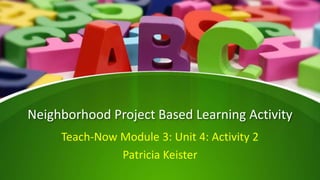Teach-Now Module 3 Unit 4 Activity 2
- 1. Neighborhood Project Based Learning Activity Teach-Now Module 3: Unit 4: Activity 2 Patricia Keister
- 2. Neighborhood Activity: Learning Outcomes  Students will learn about the community/neighborhood and occupations.  Students will gain an understanding of how a neighborhood is interconnected and why each member is important.  Students will discuss ways to alleviate traffic issues in the neighborhood around their school and present these ideas to the School Manager.
- 3. Project Description: 1. Construction Students will use recycled materials to build a neighborhood • In groups of three or four students will work together to design their chosen or assigned place in a neighborhood • Students will design, build, paint, and decorate their place • As a class students will paint a large mapped area of the neighborhood including green land space and blue water area; some students can be given the task of engineer and construct bridges where necessary
- 4. Example of what the neighborhood may look like when finished
- 5. Project Description: 2. Play Based Learning Students will use occupation dolls (made from toilet paper rolls) to play with their neighborhood. • Students can create their occupation dolls to either match their constructed place in the neighborhood, or to match what they want to be when they grow up • Students can practice the vocabulary of the location and occupation while playing • Students can gain a better understanding of how a community or neighborhood relies on other members through their play
- 6. Example of what the occupation dolls may look like when finished
- 7. Neighborhood Locations and Occupations Location • Hospital • School • Supermarket • Airport • Library • Fire Station • Restaurant Occupation • Doctor, Nurse • Teacher, Custodian • Cashier • Pilot • Librarian, Author • Firefighter • Server, Chef Possible Ideas:
- 8. Project Description: 3. Presentation Students will present their place in the neighborhood to the class • Students will work with their group to present their place in the neighborhood • Students will tell about their place and who works there (occupation) • Students will describe where it is located on the map using both geographical descriptions (i.e. ‘near the river’) and/or in relation to the rest of the neighborhood (i.e. ‘to the left of the library’) • Lastly, students will tell about what they learned during the project
- 9. Project Extension: 4. Problem Solving Students will be presented with the problem that is very familiar to them in Ho Chi Minh City-traffic. Students will be asked to look at their neighborhood and find solutions to the traffic problems that we can apply to their own neighborhood around the school. • Students will work with their group to think up solutions using the model neighborhood they built, as well as toy cars • Students will draw out their solutions on provided templates of the neighborhood • Finally, student groups will present their solutions to the class • Once all groups have presented, the class as a whole will reflect on the solutions and think how those solutions could be applied to the neighborhood around the school that deals with traffic jams everyday when students are dropped off at school • Teachers and students can choose one solution to apply to the school and practice to present this idea to the School Manager
- 10. • Activity is designed for Preschool ESL learners in Ho Chi Minh City but can easily be adapted for Kindergarten and Early Elementary students or ESL students anywhere • Activity can be used to teach community or neighborhood themes/vocabulary, maps, direction, architecture and design, occupations • Uses 21st century skills: collaboration, communication, creativity, problem solving Neighborhood Activity
- 11. This activity will lead to deeper understanding of community and occupations because students are designing the places and reenacting the roles in the neighborhood. With role playing, students are learning a concept by doing. It is engaging, interesting, and helps students practice their speaking skills using the new vocabulary. By working to solve a real problem that students face everyday, they feel more engaged in the activity and can see the importance of their classwork. Deeper Understanding
- 12. References Bender, William N. (2012) Project-Based Learning: Differentiating Instruction for the 21st Century. Thousand Oaks, California: Corwin. Ford, Paula. (2016) Project-Based Learning Gives Kindergarteners Agency. Retrieved from http://www.personalizelearning.com/2016/03/project-based-learning- gives.html Marzilli, Angela. (2016) Creating Authentic Kindergarten PBL. Retrieved from https://www.bie.org/blog/creating_authentic_kindergarten_pbl












